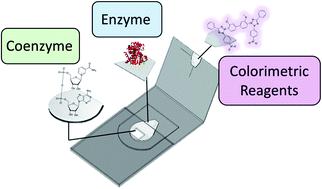当前位置:
X-MOL 学术
›
Anal. Methods
›
论文详情
Our official English website, www.x-mol.net, welcomes your
feedback! (Note: you will need to create a separate account there.)
Dry storage of multiple reagent types within a paper microfluidic device for phenylalanine monitoring
Analytical Methods ( IF 2.7 ) Pub Date : 2021-1-19 , DOI: 10.1039/d0ay02043e Lael Wentland 1 , Rachel Polaski , Elain Fu
Analytical Methods ( IF 2.7 ) Pub Date : 2021-1-19 , DOI: 10.1039/d0ay02043e Lael Wentland 1 , Rachel Polaski , Elain Fu
Affiliation

|
The degradation of biochemical reagents on the timescale of weeks can severely limit the utility of microfluidic assays intended for field use, and is a challenging aspect of microfluidic device development in general. Our study focuses on the evaluation of the dry storage stability of three types of reagents: (i) the colorimetric reagents nitroblue tetrazolium and 1-methoxy-5-methylphenazinium methylsulfate, (ii) the enzyme phenylalanine dehydrogenase, and (iii) the coenzyme β-nicotinamide adenine dinucleotide hydrate, within the context of a phenylalanine monitoring device. We have demonstrated stable dry storage of each of the reagents, over the time span of approximately one month. Drying the colorimetric reagents under nitrogen was found to largely suppress reagent degradation and the appearance of nonspecific signal, while the enzyme and coenzyme retained activity when stored dry for a month without additional processing or chemical additives. Finally, phenylalanine monitoring devices with all three reagent types dried down and stored for 15 days showed comparable functionality to devices containing freshly-dried reagents – a key milestone to enable future clinical testing.
中文翻译:

用于苯丙氨酸监测的纸微流体装置内多种试剂类型的干式存储
生化试剂在数周时间尺度上的降解会严重限制用于现场使用的微流控检测的效用,并且通常是微流控设备开发的一个具有挑战性的方面。我们的研究侧重于评估三种试剂的干燥储存稳定性:(i) 比色试剂 nitroblue tetrazolium 和 1-methoxy-5-methylphenaziniummethylsulfate,(ii) 苯丙氨酸脱氢酶,和 (iii) 辅酶 β -烟酰胺腺嘌呤二核苷酸水合物,在苯丙氨酸监测装置的范围内。我们已经证明了每种试剂在大约一个月的时间跨度内都能稳定干燥储存。发现在氮气下干燥比色试剂可以大大抑制试剂降解和非特异性信号的出现,而酶和辅酶在干燥储存一个月后仍保持活性,无需额外的加工或化学添加剂。最后,将所有三种试剂类型都干燥并储存 15 天的苯丙氨酸监测设备显示出与含有新鲜干燥试剂的设备相当的功能——这是实现未来临床测试的关键里程碑。
更新日期:2021-01-19
中文翻译:

用于苯丙氨酸监测的纸微流体装置内多种试剂类型的干式存储
生化试剂在数周时间尺度上的降解会严重限制用于现场使用的微流控检测的效用,并且通常是微流控设备开发的一个具有挑战性的方面。我们的研究侧重于评估三种试剂的干燥储存稳定性:(i) 比色试剂 nitroblue tetrazolium 和 1-methoxy-5-methylphenaziniummethylsulfate,(ii) 苯丙氨酸脱氢酶,和 (iii) 辅酶 β -烟酰胺腺嘌呤二核苷酸水合物,在苯丙氨酸监测装置的范围内。我们已经证明了每种试剂在大约一个月的时间跨度内都能稳定干燥储存。发现在氮气下干燥比色试剂可以大大抑制试剂降解和非特异性信号的出现,而酶和辅酶在干燥储存一个月后仍保持活性,无需额外的加工或化学添加剂。最后,将所有三种试剂类型都干燥并储存 15 天的苯丙氨酸监测设备显示出与含有新鲜干燥试剂的设备相当的功能——这是实现未来临床测试的关键里程碑。











































 京公网安备 11010802027423号
京公网安备 11010802027423号